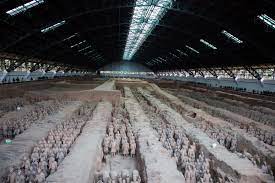THE MYSTERY OF THE QIN SHIHUANG MAUSOLEUM
Archaeologists have unraveled the mysterious plan of the Qin Shihuang Mausoleum, built 2,200 years ago and made famous by the discovery in 1974 of 7,000 warriors and terracotta horses.
Located in Xi'an in northwest China's Shaanxi Province, the Qin Shihuang Mausoleum is the tomb of Emperor Qin Shihuang, the first Emperor of the Qin Dynasty (221 - 207 BC) and from all over China.
Covering an area of 2.13 square km, the mausoleum, established on four levels, like a well-organized city, includes a palace in the basement, considered to be the center of the mausoleum, an indoor city, an outdoor city and land.
Yuan Zhongyi, a mausoleum specialist and honorary curator of the Qin Museum of Terracotta Warriors and Horses said,
" The exposure of this structure is the maximum achievement in the study of the Qin Shihuang Mausoleum in the former 40 years earlier"
Since the examen of the Qin Shihuang Mausoleum continued before forty years, archaeologists have discovered structures around hundreds of square kilometers and approximately 600 burials buried alive with their emperor.
Nevertheless, the plan of the total exterior of the cemetery remained a enigma.
The cemetery, looking east, is a square with 85 meters angling from south to north. The ramparts of the inner town and the outside town are all 12 kilometers long and are alike to those of Xi'an during the Ming dynasty (1368 1368-1644).
 |
| [This picture is collected from Pixabay By Jack78 which is licensed under CC Public Domain] |
The underground palace, the nucleus, resides under the site of the tomb mound in the south of the inner city. It symbolizes the antique real manor of Qin Shihuang during his time, and occupies two-thirds of the southern portion of the internal town.
The position of the burial mound is the observable part of Qin Shihuang's burial that sightseers can observe.
The inner town has the most edifice and buried relics, namely, the sarcophagus place, flags and forts for honor watchmen and depositories. The lower edifices and the burials for the mistresses of the monarch were also in the inner town.
Archaeologists found a stables, 31 rooms to keep rare birds and animals, 48 tombs where warriors were buried alive with their emperor and also found 3 official buildings surrounded by gardens and temples. Some lower level structures such as large trench containing stone and terracotta statues have been found in this area.
 |
| [This picture is collected from PxHere which is licensed under CC Public Domain] |
Outside the exterior town, alongside the famed fighters and terracotta equines, archaeologists have begin 98 chambers for small troops and numerous burials for those buried with Emperor Qin Shihuang.
The doors of the interior and exterior cities to the west and east were built in the form of courtyards. The town wall in the tomb has priories on both sides with turrets at the four intersections.
Emperor Qin Shihuang was the first emperor of China to build a mausoleum city and to have coffin chambers and subordinate palaces built within the mausoleum. It was also he who started the ritual and established the building rooms to buried alive on a large scale along with the tomb owner. Another unusual finding is that the mausoleum does not have a tomb for the empress.



0 Comments